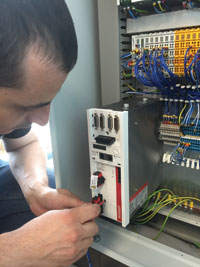
Posted to News on 26th Oct 2016, 00:00
Waiting for the new industrial revolution
Ian Jones, principal engineer at high performance engineering consultancy KWSP, believes the increasing use of IPCs is central to the delivery of Industry 4.0.

Industry 4.0 is certainly one of the manufacturing buzzwords of 2016. And while its transformational promise is yet to be fully realised in the UK, there are several building blocks within our engineering infrastructure that need to be established before the digital revolution can take place. A crucial element within manufacturing DNA is the automated control system. This function has been traditionally undertaken by the PLC – a very robust, albeit monolithic, solution to automation control that has been around since the late sixties
Despite their proven reliability and functionality, the adoption of traditional PLC is waning. Developed to be used in well-established manufacturing scenarios, they create very solid, tailor-made control platforms. However, they tend to be expensive hardware and can take a long time to develop. Another potential downside to traditional PLCs is their relatively slow introduction of new products, which is only as fast as the supplier. Hence, as a manufacturer in a dynamic and demanding environment, you can be burdened with a control platform that is simply no longer fit for purpose.
Industrial PCs (IPCs) are still seen as the new kids on the control block, despite the fact that the technology has been around since the early nineties. Only now has its more widespread adoption become apparent. The impressive turnover growth of companies such as Beckhoff provides a useful illustration of the remarkable rate of growth IPCs have enjoyed over the last decade. While the German automation specialist generated an annual turnover of approximately €150m in 2005, by 2015 this figure had risen to €620m. That’s an increase in sales of more than 31% every year for the last ten years or more.
However, despite the significant growth in IPC sales, their adoption is still not universal, with many incumbent PLC systems still dominating the industrial control landscape. However, the emergence of affordable and highly functional control codes in PC hardware is set to provide IPCs with an additional growth impetus.
New process automation protocols, such as EtherCAT, offer open source functionality, which allow control systems to talk to each other. This enables engineers to create EtherCAT modules, which can plug into different equipment, bringing much more flexibility. In turn, this means that software modules can be accessed and shared much more readily, therefore bringing down the cost of control automation. Whilst this was previously possible via bus systems such as Profibus, Devicenet and Modbus, the open nature, reduced hardware costs and short update times of this modern protocol make it an obvious choice.
This more agnostic approach to control technology means that design engineers are less tied to technology partners who can sometimes unwittingly slow down developments, and the technology’s closed nature drives certain solutions. Increasingly, we’re seeing engineers using large databases of software components, without the traditionally large infrastructure or cost associated with this kind of processing power. The tables have now turned in favour of dynamic, plug-in and play control platforms, so that engineers can even use a Raspberry Pi to run automation. And this is where the implication for Industry 4.0 become truly exciting.
Without the need for expensive, fixed control systems, engineers have the power to explore and experiment in ways that were previously not possible. Industry 4.0 is underpinned by the ethos to share innovation and IPCs are a cornerstone of that new manufacturing infrastructure. This PC-based approach also enables system interrogation to take place far more quickly and cheaply as modern programming techniques and open source protocols allow a more robust and stable underlying architecture.
PLCs and automation generally don’t need lots of processing power, as most machines can run on something that is not much more powerful than a mobile phone or even a Raspberry Pi. This sea change has heralded a new era in automation control whereby hugely powerful sensors and hardware are now available to engineers, but ten times cheaper than the well-established industrially packaged sensors.
Clearly, data collection and analysis is becoming easier and cheaper. The savvy machine builder of the future is going to be able to choose a better automation solution, by knowing the best way to collect and interrogate data, as well as the appropriate devices (of appropriate cost) to collect it. The exciting prospect here is the fact that engineers will no longer be shackled by the inflexible systems of old. The opportunities for IPC-driven machine building are massive.
This more flexible, affordable IPC-based approach to automation control is already gaining a strong following among ‘early adopter’ engineers and will soon become the system of choice for design engineers in other more traditional sectors. While it is not a silver bullet solution, the wider adoption of IPCs is a key enabler towards the realisation of the digital factory and the Industry 4.0 aspiration.










